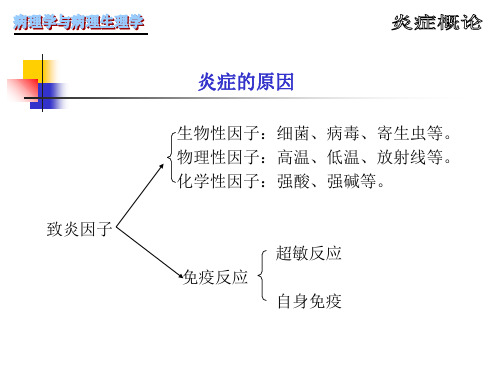病理学-炎症学习课件
病理学炎症专题知识培训ppt课件

病理学炎症专题知识
28
. 病理学(第9版)
五、急性炎症的病理学类型
➢浆液性炎 ➢纤维素性炎 ➢化脓性炎 ➢出血性炎
病理学炎症专题知识
29
. 病理学(第9版)
(一)浆液性炎
➢特点:以浆液渗出为主 ➢渗出的浆液可以来自血浆,也可由浆膜的间皮细胞分泌 ➢急性炎症早期 ➢好发部位:疏松结缔组织、浆膜、黏膜及皮肤
缓激肽
血浆(由肝脏产生)
血管通透性升高,平滑肌收缩,血管扩 张,疼痛
凝血酶
血浆(由肝脏产生)
内皮细胞激活,白细胞渗出
病理学炎症专题知识
27
. 病理学(第9版)
四、 急性炎症反应的终止
➢炎症介质降解:炎症反应逐渐减弱 ➢中性粒细胞凋亡:离开血液循环后, 中性粒细胞于数小时至两天内发生凋亡而死亡 ➢释放终止信号:例如脂质素、 TGF- β、 IL-10等,主动终止炎症反应
非炎症 <30g/L <1.018 通常<100×106/L 不自凝 清亮
病理学炎症专题知识
11
• 病理学(第9版)
三、炎症的基本病理变化
( 三 ) 增 生 ( proliferation)
➢定义:炎症的修复过程,实质细胞和间质细胞均可发生增生,并伴有大量淋巴、单核/巨 噬细胞增生。
➢增生的成分
l 实质细胞:被覆上皮、腺上皮等
病理学炎症专题知识
15
• 病理学(第9版)
(三)炎症的意义
➢阻止病原微生物蔓延:渗出的纤维素交织成网,可限制病原体的扩散 ➢消灭病原体:渗出的补体、抗体和白细胞可消灭、清除病原微生物 ➢修复损伤组织:通过实质细胞和间质细胞的增生,恢复组织和器官的功能
病理学炎症专题知识
《病理学-炎症》课件

信号分子和细胞外基质的代谢产物展开反应,导致血管扩张。
渗出物
有白细胞和蛋白质的浆液体从血管向组织间隙渗出,形成水肿。
炎细胞浸润
白细胞的数量和种类发生变化,以应对不断加剧的外界压力。
中期炎症的病理学特点
内皮细胞重新排列
吞噬作用
胶原沉积
此时,渗出液中包含更多的细胞,
白细胞使用吞噬功能摄取细菌、
安全用药指南
在炎症治疗过程中,药物的正确使用是非常重要的。我们需要了解每一种药物的作用和不良反应,并始终按照
医生的建议进行用药和治疗。
炎症知识普及和宣传的重要性
通过加强炎症知识普及和宣传,我们能够帮助大众更好地了解该疾病,提高对于健康的关注和应对能力,同时
促进更有效的医疗服务和疾病预防。
除。然而,过度的炎症也可能会
状。
一系列反应的发生。
对身体造成损害。
炎症的分类和类型
1
急性炎症
2
true
3
自身免疫性疾病
true
慢性炎症
true
4
感染炎症
true
怎样引起炎症?
1
外界刺激
例如细菌、寄生虫等等
化学物质
2
例如烟草、氧化物等等
3
自身免疫
例如疾病和遗传因素
早期炎症的病理学特点
灶外科切除。
节体内炎症反应。
炎症与自身免疫性疾病的关系
关联性
炎症与自身免疫性疾病密切相关;例如,类风湿性关节炎、系统性红斑狼疮等。
机理
自身免疫性疾病是由体内免疫系统对于自身组织的攻击引起的,类似于一种慢性炎症反应。
治疗
用于控制炎症的药物也可用于治疗自身免疫性疾病,但常常需要更加复杂的治疗方案。
《病理学》炎症 ppt课件

功能相关抗原 (integrins LFA-1)
分子构象改变
医学 34
白细胞黏附的机制——黏附分子向细胞表面再分布
WBC
P-选择素
组织胺 凝血酶
医学
35
白细胞黏附的机制——增加黏附分子的合成和表达
WBC
IL-1 TNF
医学
36
白细胞黏附的机制——增加黏附分子的亲和力 配体ICAM-1
整合素LFA-1
影响液体渗出的因素
血管通透性 permeability
血管内流体静力压 blood pressure
组织渗透压 osmotic pressure
医学
21
(1)血管通透性增高
increased permeability 原因
致炎因子与炎症中化学物质作用结果
医学
22
表现
内皮细胞收缩、间隙增宽(0.5~1mm)
医学 16
变质 / 渗出 / 增生
- 顺序性/重叠性/相对为主性/相互转化性
- 保护性/损伤性
医学
17
第二节
急性炎症
血管反应
液体(血浆)的渗出
液体渗出的过程
医学
18
正常的血液轴流状态
短暂收缩、血管扩张 血流速度加快 血管继续扩张 通透性增高 血浆成分渗出
医学 19
浆液及纤维 蛋白渗出
医学
20
医学
45
白细胞的作用
(1)吞噬杀灭作用 phagocytosis 中性白细胞 吞噬作用
酸性水解酶、中性蛋白酶
髓过氧化物酶、溶菌酶
医学 46
巨噬细胞 吞噬作用
活化、递呈抗原
合成分泌
医学
47
病理学 第三章 炎症 ppt课件

第三节 炎症局部的基本病理变化
由于毛细血管内流体静压增高(如心力衰竭导致的静 脉淤血)或某些疾病(如肝硬化、肾炎、营养不良)引起 的低蛋白血症,血浆胶体渗透压降低,也可使组织间隙或 体腔内液体含量增多,这种情况所增多的液体称为漏出液。
渗出液主要取决于血管壁通透性的增高。
33
第三节 炎症局部的基本病理变化
炎性渗出液与非炎性漏出液聚集于体腔者,均称为体 腔积液(如腹腔积液、胸腔积液、心包积液等)。
所以,临床上遇到体腔积液的患者,首先应当鉴别是 炎症引起的渗出液还是其他疾病引起的漏出液,以便明确 诊断、制定合理的治疗方案。
34
第三节 炎症局部的基本病理变化
渗出液与漏出液的区别
渗出液
原因
炎症
外现
混浊
蛋白含量 30g/L以上
(通过神经反射和某些化学介质的作用) 1.细动脉短暂痉挛、收缩(本能退让防御持续几秒钟或几分钟)
(通过轴突反射和炎症介质的作用)
2.(细动脉、毛细血管)血管扩张、血流加快→动脉性充血
`
(红 、肿)
炎症介质及局部酸中毒影响,
毛细血管和小静脉进一步扩张 炎性充血(持续几小时)
29
3. 血管壁通透性增加,血流减慢 →液体渗出→血液浓缩、粘 稠 。为液体渗出创造条件 血流停滞,轴流加宽 (利于各种物质参与炎症反应) 白细胞靠边或附壁→以阿米巴运动游出血管进入炎症区域 。
30
第三节 炎症局部的基本病理变化
(二)液体渗出 在炎症早期,由于炎性充血,使血管内流体静压升高,
继之血管壁通透性增高,血浆蛋白渗出血管外,使血浆胶 体渗透压降低而组织间隙胶体渗透压升高,导致大量的液 体及细胞从血管内逸出到血管外,进入组织间隙,此过程 即为渗出。
《病理学_炎症》课件

炎症的分类
急性炎症
急性炎症发生迅速,主要通过中性粒细胞的浸润、血管扩张和组织液渗出表现出明显炎症反 应。
慢性炎症
慢性炎症发展缓慢,与细胞浸润、组织损伤及修复同时进行。它往往持续时间较长,可能导 致组织结构和功能的改变。
无症状炎症
一些炎症可能没有明显的临床表现,但仍能引发病理改变,例如慢性低度炎症。
1
1. 血管反应
炎症引起血管扩张、血流减慢以及通透性增加。这为后续的细胞浸润提供了条件。
2
2. 白细胞浸润
白细胞(如中性粒细胞和单核细胞)从血液进入炎症部位,通过趋化因子的作用 聚集并发挥其免疫功能。
3
3. 炎症介质释放
炎症过程中,细胞释放多种炎症介质,如细胞因子、趋化因子和炎症介质,调节 并促进炎症反应的进行。
炎症的临床表现因其类型和程度而异,可能包括疼痛、红肿、温热和功能障 碍等。正确识别炎症的临床表现对于指导治疗和判断病情非常重要。
炎症与免疫系统的关系
免疫系统在炎症过程中起到重要作用,介导炎症反应并参与其调节。炎症和 免疫系统之间密切的相互作用杂多样,包括感染、免疫反应异常、组织损伤、代谢紊乱等。了解病因对于制定合 适的治疗和预防策略至关重要。
炎症的病理生理
炎症的发生与机体的保护性反应有关,它有助于清除感染源、移除坏死组织 并促进修复过程。然而,过度或长期的炎症反应可能会导致组织损伤和疾病 发展。
炎症的临床表现
《病理学_炎症》PPT课件
欢迎参加今天的病理学课程!本节课我们将深入研究炎症的定义、病理过程、 分类以及与免疫系统的关系。让我们一起探索炎症所涉及的各个方面。
炎症的定义
炎症是一种复杂的生理反应,通常由组织损伤、疾病或外部刺激引起。它包 括局部血液循环的改变、白细胞的浸润和炎症介质的释放。
病理学第4章炎症-PPT文档

压迫器官和组织 机化、粘连
3.白细胞渗出——炎细胞浸润
(1)渗出过程
边集 粘附 游出 趋化作用
①白细胞边集:白细胞离开轴流,沿内皮细胞表 面滚动。
②白细胞粘附:白细胞和内皮细胞表面粘附分子 相互识别、相互作用,使白细胞粘附于内皮细 胞表面。
③白细胞游出:白细胞以阿米巴样运动穿出血管壁。 ④白细胞趋化作用:白细胞向趋化因子作定向移动。
见于急性炎症后期, 慢性炎症,非化脓性 炎以及病毒、寄生虫 感染时。
(3)炎细胞种类、功能及临床意义(续)
类别
功能
临床意义
嗜酸性粒细胞
吞噬抗原抗体复合物及 组胺。
具有抗过敏作用,见 于寄生虫感染、超敏 反应性疾病及急性炎 症后期。
淋巴细胞 及浆细胞
T细胞参与细胞免疫, 致敏后产生淋巴因子, 杀伤靶细胞;B细胞在 抗原刺激下转变为浆细 胞,产生抗体参与体液 免疫过程。
(3)局部疼痛
全身反应
(一)发热 机制:致炎因子
单核巨噬细胞 内生致热原
体温调节中枢调定点上移
↑体温
有利:提高机体防御能力 意义 有害:过高发热 损害脑功能
长期发热 机体消耗↑
散热↓ 产热↑
(二)白细胞变化 急性化脓性炎症 N ↑ 甚出现核左移、中毒颗粒 过敏或寄生虫性炎 E ↑ 某些病毒感染 L ↑ 某些病原体如流感病毒、伤寒杆菌感染、WBC正常或减 少。
局部表现
(一)红:动脉性充血(鲜红) 静脉性充血(暗红)
(二)肿: 急性炎症 慢性炎症
炎性水肿所致 局部组织增生所致
(三)热:血管扩张、代谢增强、产热增加所致
(1)分解代谢 (四)痛: (2)局部肿胀
(3)炎症介质
H+K+刺激神经末梢 压迫神经末梢 刺激神经末梢
《病理学炎症》课件

针对炎症的病因进行治疗,如 抗感染、抗过敏、抗肿瘤等。
对症治疗
缓解患者的症状,如解热、镇 痛、抗炎等。
支持治疗
保持患者的水、电解质平衡, 补充营养,增强免疫力等。
预防并发症
及时处理可能出现的并发症, 如感染、休克等。
抗炎药物的应用
非甾体抗炎药
如阿司匹林、布洛芬等,主要用于缓解轻中 度疼痛和发热。
如烟草、酒精、化学物质等有害物质,减 少接触可以降低非感染性炎症的风险。
合理使用药物
不滥用药物,避免药物性炎症的发生。
健康生活方式
保持充足的睡眠、均衡的饮食、适当的运 动,有助于降低非感染性炎症的风险。
自身免疫性疾病的预防和控制措施
避免诱发因素
了解自身免疫性疾病的诱发因素,如某些食物、 药物、感染等,尽量避免接触。
《病理学炎症》ppt课件
• 炎症概述 • 炎症的病理变化 • 炎症的病因和发病机制 • 炎症的诊断和治疗 • 炎症的预防和控制
01
炎症概述
炎症定义
炎症是机体对各种刺激所发生 的反应,目的是为了消除刺激 、恢复多种细胞和分子的相互作 用。
炎症可以表现为红、肿、热、 痛等局部症状,也可以引起发 热、心率加快等全身反应。
炎症反应具有保护作用,同时也会对机体造成一定的损伤。
炎症的病理生理学变化
炎症过程中,局部组织会释放多 种化学因子和细胞因子,引起血 管扩张、通透性增加和白细胞渗
出等反应。
炎症反应会导致局部组织缺氧、 代谢紊乱和组织坏死等病理生理
学变化。
炎症反应还可能引起全身反应, 如发热、疼痛和免疫功能异常等
。
炎症的病理组织学变化
炎症的组织学特征包括血管扩张、充 血和渗出,以及炎细胞的浸润和渗出 。
病理学第四章炎症PPT课件

目录
• 炎症的定义和概述 • 炎症的病因和发病机制 • 炎症的临床表现和诊断 • 炎症的治疗和预防
01 炎症的定义和概述
炎症的定义
炎症是指机体对于刺激的一种防 御反应,表现为红、肿、热、痛
和功能障碍。
炎症反应是机体的一种保护性机 制,旨在清除有害刺激物并促进
组织修复。
诊断方法
感染性炎症的诊断通常依赖于医 生的临床观察和实验室检查,如 血常规、尿常规、细菌培养和组 织活检等。
非感染性炎症的临床表现和诊断
临床表现
非感染性炎症的症状可能包括疼痛、 肿胀、发热和乏力等,通常没有明显 的感染病灶。
诊断方法
非感染性炎症的诊断需要排除感染和 其他病因,通过实验室检查和影像学 检查等方法进行诊断。
自身免疫性疾病的临床表现和诊断
临床表现
自身免疫性疾病的症状可能包括关节疼痛、肿胀、僵硬和皮疹等,严重时可累 及全身多个器官。
诊断方法
自身免疫性疾病的诊断依赖于医生的临床观察和实验室检查,如自身抗体检测、 免疫功能检测和组织活检等。
04 炎症的治疗和预防
感染性炎症的治疗和预防
根据病原体类型选择合适的抗生素
对自身组织产生攻击和损伤。
发病机制
自身免疫性疾病的发病机制涉及 多个环节,包括自身抗体的产生、 免疫细胞的活化、炎症介质的释
放等。
总结
自身免疫性疾病的发病机制是一 个复杂的过程,需要深入研究和 理解,以寻找有效的治疗策略。
03 炎症的临床表现和诊断
感染性炎症的临床表现和诊断
临床表现
感染性炎症通常表现为红、肿、 热、痛等症状,如皮肤发红、肿 胀、发热和疼痛等。
。
血管反应
- 1、下载文档前请自行甄别文档内容的完整性,平台不提供额外的编辑、内容补充、找答案等附加服务。
- 2、"仅部分预览"的文档,不可在线预览部分如存在完整性等问题,可反馈申请退款(可完整预览的文档不适用该条件!)。
- 3、如文档侵犯您的权益,请联系客服反馈,我们会尽快为您处理(人工客服工作时间:9:00-18:30)。
InflammationSkin blister result from burning Serous effusion accumulated within and underneath the epidermis of skinCarbuncle(痈) Furuncle(疖)Outlines of inflammation●General Considerations➢Definition; Inflammatory agents; Basic pathological changes ofinflammation; Local and systemic manifestations of Inflammation ●Acute inflammation➢The process of vascular and cellular events in inflammation,Inflammatory mediators➢The classification and outcomes of acute inflammation●Chronic inflammationPart 1 General ConsiderationsDefinitionInflammation is a protective response intended to eliminate the initial cause of cell injury as well as the necrotic cells and tissues resulting from the original insult.Components of acute and chronic inflammationInflammatory agents●Infections (bacterial, viral, parasitic) and microbialtoxins●Physical agents (e.g., irradiation, burns) and Trauma(blunt and penetrating)●Chemical agents (some environmental chemicals)●Ischemic and necrotic tissues●Foreign particle (dirt, sutures)●Allergic reactionsThe basic pathological changes●Alteration (degeneration, necrosis)●Exudation (hallmark, vascular change, leukocyte reaction, inflammatory mediators )●Proliferation (parenchymal and strmal cells)Exudation of plasma proteinsExudate and transudateCause inflammation non-inflammation Gross cloudy clearGravity >1.018 <1.018 Protein >30g/L < 30g/LCell no. >100/mm3<100/mm3 Coagulation + -Mucoprotein + -Local manifestations of Inflammation ●rubor (redness)●tumor (swelling)●calor (heat)●dolor (pain)Systemic manifestations of inflammation●Fever●Increased acute-phase proteins●Leukocytosis●Others: increased pulse and bloodpressure; decreased sweating; rigors;anorexiaPart 2 Acute inflammationThe process of acute inflammation ●Vascular events●Cellular events●Molecular eventsVascular Events●Changes in vascular caliber and flow➢Transient vasoconstriction of arterioles at the site of injury➢Vasodilation of precapillary arterioles then increases blood flow to the tissue●Increased vascular permeabilityThe major local manifestations of acute inflammation: (1)vascular dilation; (2) extravasation of plasma fluid and protein; (3) leukocyte emigration and accumulation in the site of injuryCellular Events1) Recruitment of leukocytes to sites of infection and injury2) Recognition of microbes and dead tissues3) Removal of the offending agents4) Release of leukocyte products and leukocyte-mediated tissue injury1) Recruitment of leukocytes to sites of infection and injury●Margination, rolling and adhesion toendothelium●Leukocyte migration throughendothelium●Chemotaxis and activationThe multiple process of leukocyte migration through blood vessels.Robbins and Cotran Pathologic Basis of Disease 7th editionChemotaxis●After extravasating from the blood, leukocytesmigrate toward sites of injury along a chemical gradient in a process called Chemotaxis.●Chemotactic Factors including bacterialproducts, chemokines, C5a, leukotriene B 42) Recognition of microbesLeukocyte receptors and responses3) Removal of the offending agents●Phagocytosis●Engulfment●Killing and degradationA. Phagocytosis:●Attachment●Engulfment●Fusion with lysosomesB. oxygen-dependentbactericidalmechanismRobbins Basic Pathology4) Release of leukocyte products and leukocyte-mediated tissue injury●Acute inflammation: e.g., acute respiratory distress syndrome; acute transplant rejection; reperfusion injury●Chronic inflammation: e.g., arthritis; asthma; chronic lung diseaseInflammatory Mediator●Function of chemical mediators: directing the vascular and cellular events in inflammation●Cell-derived or Plasma-derived mediators●Act as a complicated networkMediators Sources ActionsHistamine Mast cells, basophils,platelets Vasodilation, increased vascular permeability, endothelial activationSerotonin Platelets Vasodilation, increased vascular permeability Prostaglandins Mast cells,leukocytesVasodilation, pain, feverLeukotrienes Mast cells,leukocytes Increased vascular permeability, chemotaxis, leukocyte adhesion and activationPlatelet-activating factor Leukocytes, mastcellsVasodilation, increased vascular permeability,leukocyte adhesion, chemotaxis, degranulation,oxidative burstReactive oxygenspeciesLeukocytes Killing of microbes, tissue damageNitric oxide Endothelium,macrophagesVascular smooth muscle relaxation, killing of microbesCytokines (TNF, IL-1)Macrophages,endothelial cells,mast cells Local endothelial activation (expression of adhesion molecules), fever/pain/anorexia/hypotension, decreased vascular resistance (shock)Chemokines Leukocytes,activatedmacrophages Chemotaxis, leukocyte activationCell-derived mediatorsGeneration of arachidonic acid metabolites and their roles in inflammationMajor effects of IL-1 and TNFMediators Sources ActionsComplement products (C5a, C3a, C4a)Plasma(produced in liver)Leukocyte chemotaxis and activation,vasodilation (mast cell stimulation)Kinins Plasma(produced in liver)Increased vascular permeability, smooth muscle contraction, vasodilation, painProteases activated during coagulation Plasma(produced in liver)Endothelial activation, leukocyte recruitmentplasma protein-derived mediatorsInterrelationships between the four plasma mediatorsRole in InflammationMediators Vasodilation Prostaglandins, Nitric oxide, Histamine Increased vascular permeability Histamine and serotonin, C3a and C5a,BradykininLeukotrienes C 4, D 4, E 4, PAF, Substance PChemotaxis, leukocyte recruitment and activationTNF, IL-1, Chemokines, C3a, C5a, Leukotriene B 4Fever IL-1, TNF, ProstaglandinsPainProstaglandins, Bradykinin Tissue damage Lysosomal enzymes of leukocytes, Reactive oxygen speciesNitric oxideRole of Mediators in InflammationInflammatoryMediator VasodilatationVascular permeabilityEDEMA VESOACTIVE MEDIATORS •Histamine •Bradykinin •C3a C5a •LT PG •PAF •NO TISUE INJURY•Trauma •Ischemia •Neoplasm •Infectious agents •Foreign particlePRODUCTION OF INFLAMMATORY MEDIATORSCHEMOTACTIC FACTORS•C 5a•LTB4•IL-8, TNF inflammatory cellsACUTEINFLAMMATION Neutrophils,Platelets,Mast cellCHRONIC INFLAMMATIONMacrophages,Lymphocytes, PlateletsClassification of inflammation ●Clinical classification●Pathological classificationClinical Classification ●Acute inflammation●Chronic inflammationCharacteristics of Acute Inflammation●Short duration: days to months●Acute injuries induced by inflammatory agents●Exudation: fluid, plasma proteins, neutrophils●Abscess formation●Complete resolution can be reached if the injury is limited or short-lived●Severe injury healing by scar formation●Spreading : septicemia, pyemia,( metastatic abscess)●Progression to chronic inflammationCharacteristics of Chronic Inflammation●Long duration: months to years●Persistent infection, prolonged exposure to harmful agents ●Prolonged tissue destruction, loss of normal structure and function●chronic inflammatory cell Infiltration: Macrophages, Lymphocytes, Plasma cells●persistent new vessel regeneration and fibroblast proliferation: Resulting in fibrosisPathological Classification●Alteration Inflammation (acute)●Exudation Inflammation (acute)●Proliferation Inflammation (chronic)Alteration Inflammation Viral hepatitis (hepatocyte necrosis) Epidemic Type B Encephalitis (neuronal necrosis)Poliomyelitis (neuronal necrosis)Alteration inflammation----Viral hepatitisExudation Inflammation ●Serous Inflammation●Fibrinous Inflammaion●Suppurative Inflammation➢Phlegnomous Inflammation➢Superficial Suppuration➢Abscess●Hemorrhagic InflammationSerous I nflammation●Features:Outpouring of a watery, relatively protein-poor fluid (effusion, with 3%-5% plasma proteins, Albumin)●Location:Mucosa, body cavities (peritoneal, pleural & pericardial cavities) , Loose connective tissues●Pathologic changes:Inflammatory edema, blister, hydrops, Catarrh●Outcome:complete resolutionSerous InflammationFibrinous Inflammation●Causes: M ore severe injuries can result in greater vascular permeability. L arger molecules(esp. fibrinogen)come out through the endothelial cells.●Pathologic changes: E osinophilic meshwork of threads or sometimes as an amorphous coagulum.●Location:Mucosa, pericardium , peritonium, body cavities, LungFibrinous Inflammation●Pathologic changes:➢Mucosa: Pseudomembraneous➢Pericardium: Shaggy heart➢Lung: lobar pneumonia●Outcome:➢Resolution:Restore normal tissue structure ➢Organization: scar formationFibrinous Inflammation of Larynx & Trachea due todiphtheriaFibrinous Inflammation of Intestine Pseudomembrane (Bacillary Dysentery)Fibrinous Inflammation of Pericardial Cavity。
